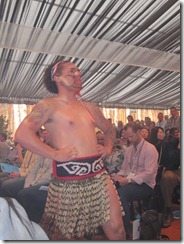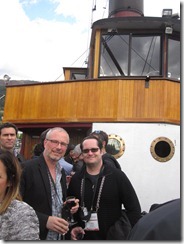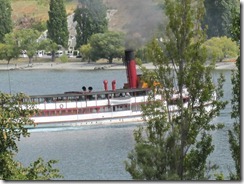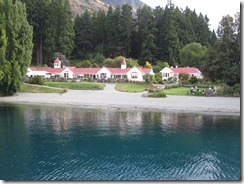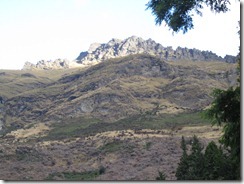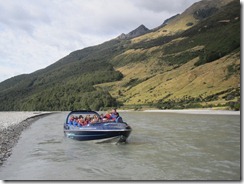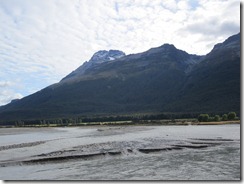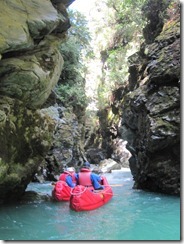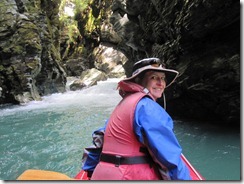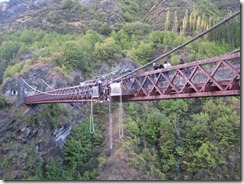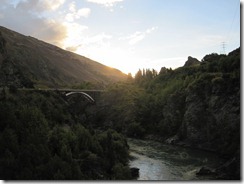After the EO event in Queenstown, Pancho and I flew up to the North Island with our buddy TBone. The three of us hit the road and toured some of the central North Island. We started out in Rotorua, south of Auckland, and a major center of Maori culture and activities.
Rotorua is notorious for its rather noxious aroma. The city sits atop one of the most active geothermal areas in the country—and that’s saying something in New Zealand. The smell of sulphur hangs over the whole town and steam vents from numerous sites, including the sewer drains. Though there are some extremely touristy areas in Rotorua, we stayed in a nice, low-key apartment near the center of town. There is a great pedestrian zone (“Eat Street”) with a number of good restaurants and bars and an outstanding little wine shop.
 | |||||||||||||||||||||||
| View from our deck in Rotorua. |
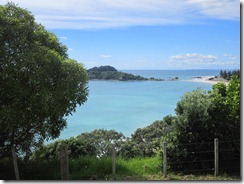 |
| View from Mt. Maunganui. |
From Rotorua, we headed toward Tongariro National Park by way of a warm-up day hike up Mt. Maunganui. Tongariro is the oldest national park in New Zealand and a World Heritage Site. Much of the land within the park is sacred to the Maori, especially the peaks of the three active volcanoes: Ruapehu, Ngauruhoe, and Tongariro. We stayed in a tiny town at the edge of the park, imaginatively named National Park. The next day we found ourselves back on the trail, with TBone in tow, hiking the Tongariro Alpine Crossing. Billed as the most spectacular and challenging dayhike in the country, the crossing covers an alpine zone between Mts.Tongariro and Ngauruhoe. The landscape is truly eerie, almost lunar, with steam vents puffing out of the ground and hardened lavaflows descending from the peaks. One of the best parts is the signage—very detailed interpretive materials outlining proper behavior in case of volcanic activity. Helpful hints like “if you see the pyroclastic flow, move quickly downhill away from it.” Ummm…DUH. Actually, I’m fairly certain that if you can see the pyroclastic flow, you only have about three seconds to live. Another useful tidbit: “Do not approach or touch the flowing lava.” Well, only if you don’t value your extremities.
 Rainbow side 1… | 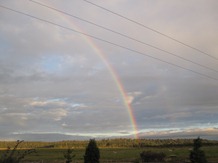 Rainbow side 2…. National Park. |
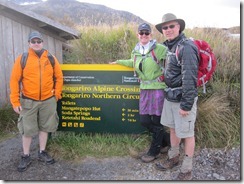 |
| Prepared for departure, Tongariro Alpine Crossing. |
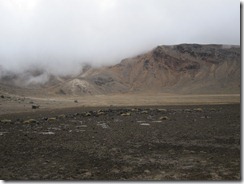 |
| Welcome to Mordor. |
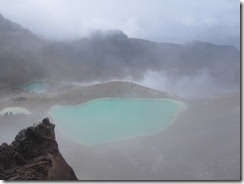 |
| Crater Lake, Tongariro. The color is due to the high mineral content. |
Of course, it’s New Zealand, so the next day is just as amazing. From Tongariro, we drove north to Waitomo, a town famous for its caves and their inhabitants, the glowworms. I’ve done a good bit of caving, but neither Pancho nor TBone had. And Pancho, at least, is more than a little claustrophobic. So they were both a little apprehensive about the caving experience. We started with a 150ft rappel into a hole in some sheep field outside of town. Then came the zipline. In the dark. Which totally rocks. You have no idea where you’re going or how far it is, then BAM—you literally hit the end of the line. Next, we hopped into innertubes and jumped off a small cliff into a subterranean river.
We paddled along the dark water with clusters of tiny glowing dots overhead. The glowworms are technically phosphorescent maggots (fly larvae) that live in the caves. They dangle threads below themselves to catch insects for food. Then they morph into flies, have sex for 48-hours straight, lay a bunch of eggs, and die. Good times. The exit from the cave is almost as dramatic as the entrance—climbing up a waterfall, out into a stream, in the middle of another field. It was a great day, and even the claustrophobes loved it.
[Sadly, we have no pictures of the glowworms at the moment. Cameras are not allowed for safety reasons and the photodisc we bought from the tour is not reading on our computer. Hopefully in the future…]
From Waitomo, it was back to Auckland, for the next part of the adventure. We hooked up with another ATL buddy, Junior, then picked up a charter boat for a couple of days sailing in the Auckland area. We planned to head to Waiheke Island, a major wine area, to do a bit of tasting with our resident oenophile, TBone. The wind was pretty lively on the way out and as we were pulling into the harbor, one of the lines snapped and our headsail was loose. We managed to get it lashed onto the deck with plans to do repairs the following morning. Not being too worried, we took off to Cable Bay Winery, a stunning contemporary complex overlooking the water and the Auckland skyline in the distance. Fabulous wines and food.
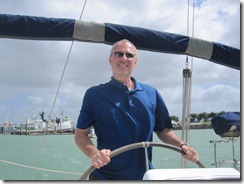 |
| Pancho in his element. |
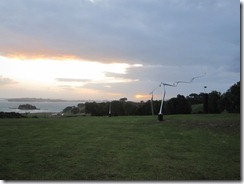 |
| Cable Bay Winery, Waiheke Island, with moving sculptures. |
Unfortunately, in the morning, we started getting calls and texts from various folks, suggesting we look at the forecast. As Pancho and I listened to the weather, we realized why. Gale warnings for the Hauraki gulf later that day. One guess as to our location and the gulf between us and Auckland. Worsening winds and seas. Yikes. Our plans were completely dashed when Pancho called the charter company and the guy said that in 20-some years, he had never encouraged anyone to come in early. But we did—motored back to Auckland with our crippled sail and parked in the marina that night. Where it was unbelievably rough and windy—I can’t imagine how it would have been at anchor off Waiheke.
It was par for the course on our New Zealand adventure, though. Things don’t always go according to plan and you just have to stay flexible and roll with the waves as they come.
